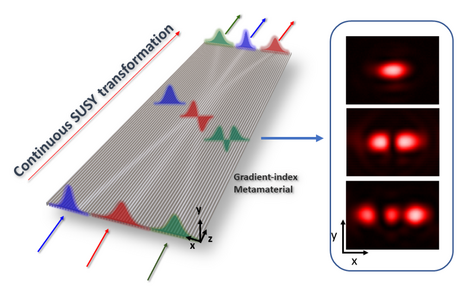The field of transformation optics has developed a flexible framework for modifying the direction of light and its spatial properties. The coordinate transformation frequently produces extreme material properties that are not practical with metamaterials.
 Continuous supersymmetric transformation is simultaneously and individually prescribed to multiple optical states (denoted by the colors: blue, red, and green) for mode-shaping and routing within the gradient-index metamaterial. The right panel presents the intensity field profiles of the individual optical states after the transformation. Image Credit: Jieun Yim, Nitish Chandra, Xilin Feng, Zihe Gao, Shuang Wu, Tianwei Wu, Haoqi Zhao, Natalia M. Litchinitser, and Liang Feng
Continuous supersymmetric transformation is simultaneously and individually prescribed to multiple optical states (denoted by the colors: blue, red, and green) for mode-shaping and routing within the gradient-index metamaterial. The right panel presents the intensity field profiles of the individual optical states after the transformation. Image Credit: Jieun Yim, Nitish Chandra, Xilin Feng, Zihe Gao, Shuang Wu, Tianwei Wu, Haoqi Zhao, Natalia M. Litchinitser, and Liang Feng
A group of researchers from the University of Pennsylvania, led by Professor Liang Feng, has created a new chip that can alter light flows by transferring distinct optical states, according to a recent publication published in eLight.
The paper aims to present an adaptable approach to tame light flow.
The principles of electromagnetics are the basis for attempts to arbitrarily change the spatial properties of light and bend it on demand. Transformation optics was developed due to Maxwell’s equations’ form-invariance under coordinate transformations.
The electromagnetic fields can be rearranged in a particular coordinate system, thanks to their equivalence.
Metamaterials permit a wide range of optical characteristics and offer significant design flexibility. The optical extremity and singularity that frequently occur from the transition have caused a decade-long impasse in the experimental realization of transformation optics. Developing novel transformation optics systems with feasible broadband parameter values is crucial.
One example is the spatially variable local index of refraction used in conformal mapping. Using inhomogeneous Si nanostructures, this approach can carry out the coordinate transformation. It can produce deft phase-front control for carpet cloaking with several colors.
This method clarified the potential for warping space using the gradient index (GRIN). A paradigm shift that goes beyond conventional coordinate transformation is necessary to obtain richer functionality in addition to twisting the trajectories.
By seeing the Hamiltonian of the system transforming, the research team departs from traditional transformation optics. Researchers know a system can be changed using a conserved quantity, thanks to the Hamiltonian’s invariance under symmetry operation.
The degenerate eigenenergy spectra between two different Hamiltonians, in particular, found in supersymmetry (SUSY), have made it possible to more precisely regulate the spatial properties of light.
High-radiance single-mode microlaser arrays and mode division multiplexing are two fascinating applications made possible by the strategic connection of the original optical system and its dissipative superpartner.
The lattice Hamiltonians used in these earlier experimental experiments can be factorized using the matrix operation. As a result, they created systems made up of numerous coupled discrete parts that were equivalent to coupled waveguides or resonators.
The extended SUSY technique, which can produce an endless number of absolutely isospectral potentials, has not been empirically tested because realizing arbitrary prospects needs a unique strategy. Its mathematical foundation is also perfect for the constant Hamiltonian transformation, enabling a unique setting for transformation optics.
The research team announced the first experimental evidence of constant SUSY transformation by creating a brand-new GRIN metamaterial on a Si platform. The goal is to create a metamaterial that can simulate any potential to convert optical medium under supersymmetry and achieve enhanced light control.
They created spatially variable dielectric permittivity by combining supersymmetry and the metamaterial. It was a two-dimensional map where arbitrary changes were simultaneously prescribed to numerous optical states for switching, routing, and sculpting spatial modes while rigorously keeping their original propagation constants. Broadband continuous SUSY transformation optics were incorporated into their output.
This study’s demonstration of the interaction between supersymmetry and a metamaterial revealed a method for fully utilizing a chip’s spatial degrees of freedom for adaptable photonic applications.
The continuous SUSY transformation method developed by the researchers is expandable to more free parameters and eigenstates. In information technologies, it creates an optimal platform for on-chip space-division multiplexing by applying it to a more complex index distribution.
A design technique to fully utilize metamaterials in three-dimensional space may also be provided by furthering the SUSY transition into higher dimensions.
Journal Reference:
Yim, J., et al. (2022) Broadband continuous supersymmetric transformation: a new paradigm for transformation optics. eLight. doi.org/10.1186/s43593-022-00023-1.